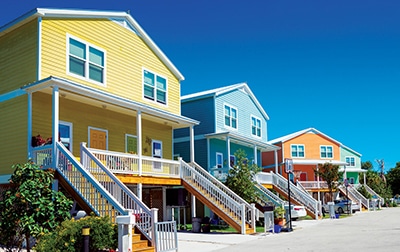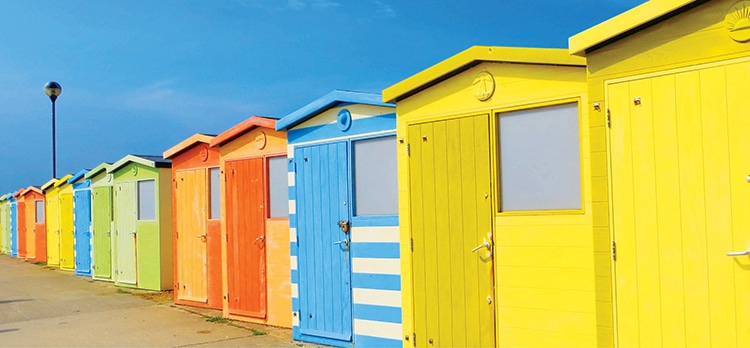Exterior architectural coatings are expected to maintain their appearance for many years despite constant exposure to sunlight, wind, rain, and harsh weather conditions. That performance is increasingly expected from thinner and thinner layers of paint, making it even more challenging to protect applied coatings from light- and heat-induced degradation. Formulators are fortunate to have access to advanced additive chemistries that can mitigate such damaging effects. Light stabilizers, including UV absorbers (UVAs) and hindered amine light stabilizers (HALS), operate by two different mechanisms, allowing the protection of many different types of coatings used in a variety of exterior applications, including architectural paints. Inorganic additives based on zinc and titanium oxides have also been explored (not covered here).
Light stabilizers, including UV absorbers (UVAs) and hindered amine light stabilizers (HALS), operate by two different mechanisms, allowing the protection of many different types of coatings used in a variety of exterior applications, including architectural paints.
A typical exterior architectural coating formulation contains resins and binders, pigments, solvents, and additives such as light stabilizers. Some of the most important properties required in these formulations include good penetration and adhesion, high durability, resistance to high and low temperatures as well as to chalking and cracking, and retention of color and appearance. To protect against degradation, surface defects, erosion, and color fading, the key factors to consider are the UV stability of the pigments, binders, and other raw materials; weather conditions, including temperature; and the direction and orientation of the exterior of the building, according to Delphine Kimpel, senior technical sales, performance additives, Europe, at BASF SE. Performance can be influenced by optimizing formulations, selecting suitable raw materials, and using durable binders and additives that provide protection against the harmful effects of light and heat, i.e., UVAs and HALS.
UVAs filter out harmful UV radiation, which prevents the degradation of both coatings and substrates, according to Mervin Wood, technical expert, performance additives, for BASF Corporation. UVAs function by converting absorved light energy into heat. Wood explains that based on the Lambert-Beer law, the absorbance A (the filter-effect of a coating), correlates linearly with the UVA concentration (c), the film thickness (the light path length d) and the extinction coefficient (ε). Using this law, it is possible to calculate the necessary quantity of UVAs needed for proper light protection at a given film thickness (d). “An increase in the UVA concentration or coating thickness results in an increased filter effect, and therefore increased protection against harmful UV radiation,” Wood says.
However, because coating thickness strongly influences the filter effect, UVAs, on their own, are inefficient in protecting the very top surface of a coating (where d approaches 0), Kimpel notes. “As a result,” she says, “they cannot effectively prevent the formation of surface defects that occur due to photodegradation under exterior conditions.” In addition, UVAs are themselves degraded over time; extended photo permanence (the time it takes to experience physical/chemical loss of UVAs during service life) and heat stability (low volatility) are basic requirements for the performance of UVAs in the final application, says Wood. The most common UVAs are based on 2-(2-hydroxyphenyl)-benzotriazole (BTZ) and 2-hydroxyphenyl-s-triazine (HPT) chemistry.
HALS are mainly derivatives of 2,2,6,6-tetramethyl piperidine (TMP). They act as radical scavengers in the autoxidation cycle and inhibit the photo-oxidative degradation of polymers in coatings, adhesives, and sealants. “The cyclical nature of the stabilization process along with the regeneration of the active species explains the high and long-term efficiency of HALS,” Wood says. Unlike UVAs, HALS largely function independently of the applied film thickness, and thus can act at the coating surface where UVAs provide minor protection. Kimpel explains that in clear coats, HALS protect against surface defects such as loss of gloss or cracking; in pigmented coatings, they can prevent chalking and discoloration.
Today, a large variety of HALS representing mono-, di- and oligo-functional TMPs are available that fulfill the requirements of the coatings industry. Wood explains that in addition to solubility and compatibility, the basicity of HALS is an important selection criterion. “Basicity determines the possible interactions of HALS with certain formulation components such as biocides, surfactants, catalysts, and certain acid-treated pigments that, if they occur, can result in limited formulation stability or the deactivation of HALS or of other additives,” he says. Alkyl-substituted HALS are basic, whereas aminoether (N-OR)-functionalized HALS are considered non-basic.
Given the different properties of UVAs and HALS, their combined use offers synergistic effects in exterior architectural coatings, where it is important to protect the entire thickness of the applied film, by allowing excellent protection against surface defects and discoloration. The use level of UVA and HALS strongly depends on the concentration of pigments (acting as UV screeners) and the final thickness of the coating. “The lightfastness or weather stability of some organic pigments can be improved by adding UVA, while the use of UVA can be disregarded for most inorganic pigments,” Kimpel notes. As previously mentioned, the required concentration of UVAs for effective protection also depends on the dry film thickness (DFT) of the coating. In addition, clear coatings require higher amounts of UVAs and lower dose levels of HALS, whereas opaque pigmented coatings require higher amounts of HALS and lower UVA dose levels, according to Wood. Importantly, both chemistries are hydrophobic in nature and thus are not washed out of exterior architectural coatings during various exterior weathering cycles, Kimpel adds.
While UVAs and HALs work well for the light stabilization of exterior architectural coatings, the shift to low-VOC water-based systems has created some challenges with respect to the incorporation of these crucial additives into paint formulations. “The long-term stability requirements are even greater than higher-VOC coatings; incorporation of hydrophobic light stabilizers into waterborne coatings could initially only be achieved using co-solvents and high-energy dispersing methods,” Wood explains. Addition of co-solvents leads to possible labeling requirements and potentially the lowering of overall coating properties due to plasticization and exudation.
Performance can be influenced by optimizing formulations, selecting suitable raw materials, and using durable binders and additives that provide protection against the harmful effects of light and heat, i.e., UVAs and HALS.
The solution was the development of high-performance waterborne dispersions. BASF, for instance, has established its Novel Encapsulation Additive Technology (NEAT) for easy integration of light stabilizers in low- to zero-VOC water-based applications. This technology has been used for the development of the BASF proprietary line of Tinuvin® DW light stabilizers. NEAT technology is solvent-free and does not require any co-solvent for its addition into paint formulations. “This product is composed of a high-performance UV absorber component and a non-
interacting HALS component, making it compatible for all resin types, especially sensitive resins,” Wood says. The novel blend also offers a superior photo-permanence and improves the durability of exterior wood substrates while providing superior color and gloss retention in exterior architectural coatings, Kimpel adds. “The accurate combination of Tinuvin-DW UVAs and Tinuvin DW HALS enables the correct stabilization of even the most critical organic pigments like Pigment Red 254, leading to unique color retention capability for more than five years of natural exposure. As a result, the proper use of BASF Tinuvin-DW light stabilizers allows our customers to significantly maintain the original color of facade coatings,” she says.
Ultimately though, Wood stresses, the accurate choice of light stabilizers is a primary factor in successful formulation of exterior architectural coatings that will retain their appearance for many years. “One must match the appropriate light stabilizer package with the intended type of architectural formulation with attention to the types of resins and binders, pigments, and solvents/water that are used,” he says. “In doing so, one can ensure the proper protection against degradation, surface defects, erosion, and color fading.”
FEBRUARY 2021 | VOL. 18, NO. 2
